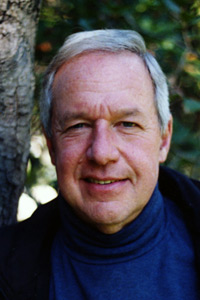Erowid Character Vaults
Nick Sand
Extended Biography
v1.0 - Nov 5, 2009
Citation: Hanna J. "Erowid Character Vaults: Nick Sand Extended Biography". Erowid.org. Nov 5, 2009.

Photo by Jon Hanna |
Sand married his first wife, Melly, while he was still in college, studying anthropology. In 1961 he first took mescaline, which sparked a life-long interest in psychedelic sacraments. During his undergraduate days, Sand put together a laboratory and successfully synthesized mescaline and several short-acting tryptamines. His attic became a new sort of temple, as Sand started turning everyone he knew on to these obscure entheogens. After meeting Richard Alpert (Ram Dass) at a lecture at Brooklyn College, Sand invited Alpert to see his lab. Sand was then summoned to Millbrook, the commune home to Timothy Leary's League for Spiritual Discovery. At Millbrook, Sand met John Griggs (founder of the Brotherhood of Eternal Love) and Owsley Stanley (creator of the first underground lab producing pure LSD1). At this point Sand began dividing his time between finishing his BA, making psychedelics, and guiding initiates in his attic and at Millbrook. He graduated from college in 1966. During a vision quest on DMT, Sand came to believe that he should devote his life entirely to manufacturing entheogens. This decision—to give up a career in anthropology and go underground to produce LSD—ultimately resulted in the break-up of his marriage. Sand became a criminal as a matter of principle and as an act of civil disobedience, because he believed he was working for a higher good. He left New York in 1967, and headed to the San Francisco Bay Area to set up a lab, where he manufactured DOM (known at the time under the street name "STP") and MDA.
From 1968 through 1969 in Windsor, California, Sand worked in an illicit lab with Tim Scully, who taught Sand how to manufacture LSD. Their material was distributed through the Brotherhood of Eternal Love, a legendary band of dealers on a mission to enlighten the world. Just like Owsley before them, Scully and Sand both felt that it was extremely important to create a product of the highest purity at a standardized dose; these goals resulted in one of the most beloved "brands" of acid in the late 1960s: tiny orange barrels containing 300 micrograms of LSD, called "Orange Sunshine ". In 2007, an ex-DEA agent who spent time analyzing Sand's acid in the 1960s remarked, "It was always high quality, and it was always a good dose."2
Although infamous because of his black-market LSD production, Sand was also the first underground chemist on record to have synthesized DMT. Sand and a lab colleague were the first people to notice that DMT exhibits piezoluminescence: when hardened DMT that had collected in a tray was being chipped out with a hammer and screwdriver in a brightly lit room, the blows emitted massive amounts of colored light. Sand was also the first person to realize that synthetic DMT could be smoked for effect; prior to this, self-experimenters were injecting DMT. This discovery came about by serendipity, when some crumbs of DMT fell onto a hotplate and vaporized, inspiring Sand to try smoking it.
Eventually Sand and Scully were arrested. Sand was told by his lawyer, Michael Kennedy, that their bust influenced the government in their massive effort to combine numerous drug control agencies (the Federal Bureau of Narcotics, the Bureau of Drug Abuse Control, and the Bureau of Narcotics and Dangerous Drugs) under one umbrella with greater power: the Drug Enforcement Administration. In 1974, Scully was sentenced to 20 years (later reduced to 10 years; he was released after 3.5 years); that same year Sand was sentenced to 15 years, but he jumped bail and relocated to Canada, where he set up a new lab. Sand met his current partner, Usha, via an international blind date arranged by a mutual friend who knew that they shared a passionate interest in psychedelics.
Sand was arrested again in 1996 in Port Coquitlam, British Columbia. His lab there produced assorted psychedelics and, at the time of the bust, had 43 grams of LSD on site. The lab was so impressive that the Royal Canadian Mounted Police used it to stage a training video. Samples of drugs seized at the lab tested at over 100% pure,3 which is clearly not possible. Alexander Shulgin has speculated that the government's reference standards must have degraded and been less pure than Sand's illicit product. Sand served time in prison from 1996 through late 2000, first in Canada, and then in the United States in fulfillment of the 22-year-old sentence that he had evaded. While in prison, Sand wrote a manuscript called Psychedelic Secrets, which lays out his thoughts on the best approaches for trippers to take when exploring their minds; he also wrote a guidebook containing his production syntheses techniques for popular psychedelics. (Both books are as yet unpublished.)
After his release, Sand gave a speech at the Mind States II conference in 2001 titled "Reflections on Imprisonment and Liberation as Aspects of Consciousness". He received a standing ovation, and has spoken at numerous events since that time. In his personal exploration of psychedelics, Sand has long been a proponent of psychopharmacological synergy. In 2006 he gave a talk at Burning Man titled "Synergistic Combinations in the Future", describing some of his favorite ways to combine two or more drugs to produce uniquely beneficial effects.
Notes #
- Although an earlier production lab for LSD was set up by Bernard Roseman and Bernard Copley, the product that they synthesized was reported to have been of questionable purity. In 1962, Roseman and Copley were charged with smuggling in relation to their LSD production, as manufacturing was not illegal at the time (Stafford P. Psychedelics Encyclopedia, 3rd Edition, page 50, 1992).
- Personal communication (2007).
- Brazil, E. "Fugitive to Face LSD Charges", SFGate.com (Jun 6, 1998).


